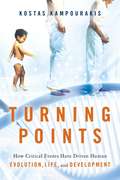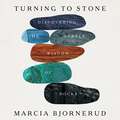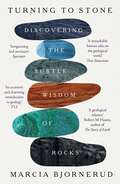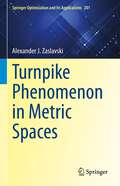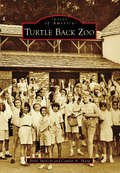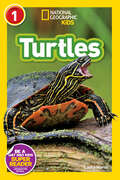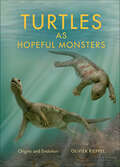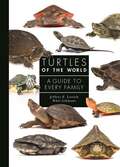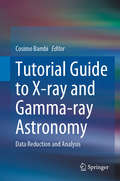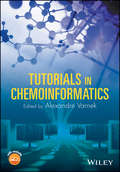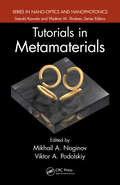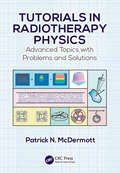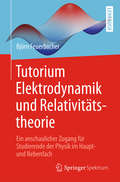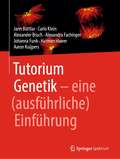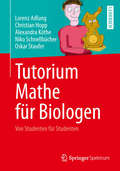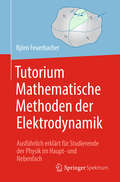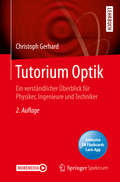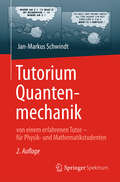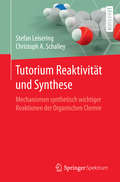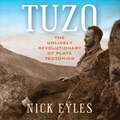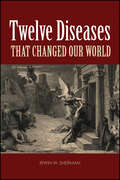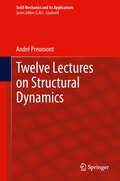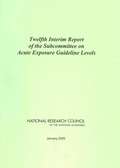- Table View
- List View
Turning Points: How Critical Events Have Driven Human Evolution, Life, And Development
by Kostas KampourakisAn accessible introduction to core concepts in evolution for lay readers, which shows that random events have played a critical role in the development of lifeCritical historical events--or "turning points"--have shaped evolution and continue to have a decisive effect on individual lives. This theme is explored and explained in this lucid, accessible book for lay readers. The author argues that, although evolution is the result of unpredictable events, these events have profound influences on subsequent developments. Life is thus a continuous interplay between unforeseeable events and their decisive consequences.As one example, the author cites the fusing of two chromosomes, which differentiated the human species from our closest animal relatives about 4 to 5 million years ago. This event was not predictable, but it had a profound effect on the evolution of our species thereafter. By the same token, certain unpredictable circumstances in the past enabled only Homo sapiens to survive to the present day, though we now know that other human-like species also once existed.The author contrasts such scientific concepts grounded in solid evidence with prevalent misconceptions about life: specifically, the religious notion that there is a plan and purpose behind life, the widespread perception that intelligent design governs the workings of nature, the persistent belief in destiny and fate, and the attribution of an overly deterministic role to genes.This excellent introduction for laypersons to core ideas in biology goes a long way toward dispelling such misconceptions and presents current scientific research in clearly understandable, jargon-free terms.
Turning to Stone
by Marcia Bjornerud'A nuanced celebration of the language of stone' DAVID GEORGE HASKELL'A unique and timeless book' ROBERT HALZENRocks are the record of our creative planet reinventing itself for four billion years. Nothing is ever lost, just transformed. Marcia Bjornerud's life as a geologist has coincided with an extraordinary period of discovery. From an insular girlhood in rural Wisconsin, she found her way to an unlikely career studying mountains in remote parts of the world. As one of few women in her field, she witnessed the shift in our understanding of the Earth, from solid object to an entity in a constant state of transformation. In the most tumultuous times of her own life, a deep understanding of our rocky planet imbued her life with meaning.The lives of rocks are long and complex, spanning billions of years and yet shaping our own human lives in powerful, invisible ways. Sandstone that filters out pathogens creating underground oases in aquifers of clean water. Ecologite is "the chosen rock" whose formation keeps the planet running. Earth is not just a passive backdrop, or a source of resources to be mined, extracted, and carved out. Rocks are full of wisdom, but somewhere along the way many of us have forgotten how to hear it.When we are uncertain about where to find truth, a geocentric worldview reminds us that we are Earthlings, part of a planetary community where we can find wisdom in the most unlikely places.
Turning to Stone
by Marcia BjornerudWINNER OF THE 2025 JOHN BURROUGHS MEDAL FOR DISTINGUISHED NATURAL HISTORY WRITING'Vast and arresting' SPECTATOR'A remarkably human take on the geological world' NEW STATESMANRocks are the record of our creative planet reinventing itself for four billion years. Nothing is ever lost, just transformed.Marcia Bjornerud's life as a geologist has coincided with an extraordinary period of discovery. From an insular girlhood in rural Wisconsin, she found her way to an unlikely career studying mountains in remote parts of the world. As one of few women in her field, she witnessed the shift in our understanding of the Earth, from solid object to an entity in a constant state of transformation. In the most tumultuous times of her own life, a deep understanding of our rocky planet imbued her life with meaning.The lives of rocks are long and complex, spanning billions of years and yet shaping our own human lives in powerful, invisible ways. Sandstone that filters out pathogens creating underground oases in aquifers of clean water. Ecologite is "the chosen rock" whose formation keeps the planet running. Earth is not just a passive backdrop, or a source of resources to be mined, extracted, and carved out. Rocks are full of wisdom, but somewhere along the way many of us have forgotten how to hear it.When we are uncertain about where to find truth, a geocentric worldview reminds us that we are Earthlings, part of a planetary community where we can find wisdom in the most unlikely places.More praise for TURNING TO STONE:'Marcia Bjornerud writes evocatively' COUNTRY LIFE'A nuanced celebration of the language of stone' DAVID GEORGE HASKELL'A unique and timeless book' ROBERT HALZEN
Turnpike Phenomenon in Metric Spaces (Springer Optimization and Its Applications #201)
by Alexander J. ZaslavskiThis book is devoted to the study of the turnpike phenomenon arising in optimal control theory. Special focus is placed on Turnpike results, in sufficient and necessary conditions for the turnpike phenomenon and in its stability under small perturbations of objective functions. The most important feature of this book is that it develops a large, general class of optimal control problems in metric space. Additional value is in the provision of solutions to a number of difficult and interesting problems in optimal control theory in metric spaces. Mathematicians working in optimal control, optimization, and experts in applications of optimal control to economics and engineering, will find this book particularly useful.All main results obtained in the book are new. The monograph contains nine chapters. Chapter 1 is an introduction. Chapter 2 discusses Banach space valued functions, set-valued mappings in infinite dimensional spaces, and related continuous-time dynamical systems. Some convergence results are obtained. In Chapter 3, a discrete-time dynamical system with a Lyapunov function in a metric space induced by a set-valued mapping, is studied. Chapter 4 is devoted to the study of a class of continuous-time dynamical systems, an analog of the class of discrete-time dynamical systems considered in Chapter 3. Chapter 5 develops a turnpike theory for a class of general dynamical systems in a metric space with a Lyapunov function. Chapter 6 contains a study of the turnpike phenomenon for discrete-time nonautonomous problems on subintervals of half-axis in metric spaces, which are not necessarily compact. Chapter 7 contains preliminaries which are needed in order to study turnpike properties of infinite-dimensional optimal control problems. In Chapter 8, sufficient and necessary conditions for the turnpike phenomenon for continuous-time optimal control problems on subintervals of the half-axis in metric spaces, is established. In Chapter 9, the examination continues of the turnpike phenomenon for the continuous-time optimal control problems on subintervals of half-axis in metric spaces discussed in Chapter 8.
Turtle Back Zoo (Images of America)
by Brint Spencer Caitlin A. SharpWith 140 animals of 40 species, the Turtle Back Zoo opened in 1963 as a seasonal children's zoo. The community and county government brought the zoo to life, while the Essex County Park Commission administered its daily functions. With funds generated from the sale of land for highway development, architects and builders selected a fairy tale, Hans Christian Andersen aesthetic for their theme. Once opened, Turtle Back Zoo was an instant success, and its popularity led to it becoming a year-round attraction that appealed to all ages. The family recreation experience came to include wildlife conservation education as well. In the early 2000s, the zoo was renovated, and a first-class animal hospital was built to serve the growing animal collection. The site is now recognized as a first-rate, modern zoo and is accredited by the Association of Zoos & Aquariums.
Turtles (Readers)
by Laura MarshTake a dip with turtles in this exciting reader. Packed with beautiful and engaging photos, kids will learn all about these fantastic reptiles. This level 1 reader is carefully leveled for an early independent reading or read aloud experience, perfect to encourage the scientists and explorers of tomorrow!
Turtles as Hopeful Monsters: Origins and Evolution (Life of the Past)
by Olivier RieppelWhere do turtles hail from? Why and how did they acquire shells? These questions have spurred heated debate and intense research for more than two hundred years. Brilliantly weaving evidence from the latest paleontological discoveries with an accessible, incisive look at different theories of biological evolution and their proponents, Turtles as Hopeful Monsters tells the fascinating evolutionary story of the shelled reptiles. Paleontologist Olivier Rieppel traces the evolution of turtles from over 220 million years ago, examining closely the relationship of turtles to other reptiles and charting the development of the shell. Turtle issues fuel a debate between proponents of gradual evolutionary change and authors favoring change through bursts and leaps of macromutation. The first book-length popular history of its type, this indispensable resource is an engaging read for all those fascinated by this ubiquitous and uniquely shaped reptile.
Turtles of Mexico
by John Legler Richard C. VogtThe Turtles of Mexico is the first comprehensive guide to the biology, ecology, evolution, and distribution of more than fifty freshwater and terrestrial turtle taxa found in Mexico. Legler and Vogt draw on more than fifty years of fieldwork to elucidate the natural history of these species. The volume includes an extensive introduction to turtle anatomy, taxonomy, phylogeny, biogeography, and physiology. A key to the turtles of Mexico is included along with individual species accounts featuring geographic distribution maps and detailed color illustrations. Specific topics discussed for each species include habitat, diet, feeding behavior, reproduction, predators, parasites, growth and ontogeny, sexual dimorphism, growth rings, economic use, conservation, legal protection, and taxonomic studies. This book is a complete reference for scientists, conservationists, and professional and amateur enthusiasts who wish to study Mexican turtles.
Turtles of the World: A Guide to Every Family (A Guide to Every Family)
by Jeffrey E. Lovich Dr. Whit GibbonsA lavishly illustrated guide to the world's turtles that covers every family and genusTurtles of the World reveals the extraordinary diversity of these amazing reptiles. Characterized by the bony shell that acts as a shield to protect the softer body within, turtles are survivors from the time of the dinosaurs and are even more ancient in evolutionary terms than snakes and crocodilians. Of more than 350 species known today, some are highly endangered. In this beautiful guide, turtle families, subfamilies, and genera are illustrated with hundreds of color photographs. Each genus profile includes a population distribution map, a table of information, and commentary that includes notable characteristics and discussion of related species.More than 250 beautiful color photosEach profile features a distribution map, table of information, and commentaryBroad coverage includes every family and genus
Tutorial Guide to X-ray and Gamma-ray Astronomy: Data Reduction and Analysis
by Cosimo BambiThis book provides a comprehensive introduction to X-ray and gamma-ray astronomy. The first part discusses the basic theoretical and observational topics related to black hole astrophysics; the optics and the detectors employed in X-ray and gamma-ray astronomy; and past, present, and future X-ray and gamma-ray missions. The second part then describes data reduction and analysis, the statistics used in X-ray and gamma-ray astronomy, and demonstrates how to write a successful proposal and a scientific paper. Data reduction in connection with specific X-ray and gamma-ray missions is covered in the appendices. Presenting the state of the art in X-ray and gamma-ray astronomy, this is both a valuable textbook for students and an important reference resource for researchers in the field.
Tutorials in Chemoinformatics
by Alexandre Varnek30 tutorials and more than 100 exercises in chemoinformatics, supported by online software and data sets Chemoinformatics is widely used in both academic and industrial chemical and biochemical research worldwide. Yet, until this unique guide, there were no books offering practical exercises in chemoinformatics methods. Tutorials in Chemoinformatics contains more than 100 exercises in 30 tutorials exploring key topics and methods in the field. It takes an applied approach to the subject with a strong emphasis on problem-solving and computational methodologies. Each tutorial is self-contained and contains exercises for students to work through using a variety of software packages. The majority of the tutorials are divided into three sections devoted to theoretical background, algorithm description and software applications, respectively, with the latter section providing step-by-step software instructions. Throughout, three types of software tools are used: in-house programs developed by the authors, open-source programs and commercial programs which are available for free or at a modest cost to academics. The in-house software and data sets are available on a dedicated companion website. Key topics and methods covered in Tutorials in Chemoinformatics include: Data curation and standardization Development and use of chemical databases Structure encoding by molecular descriptors, text strings and binary fingerprints The design of diverse and focused libraries Chemical data analysis and visualization Structure-property/activity modeling (QSAR/QSPR) Ensemble modeling approaches, including bagging, boosting, stacking and random subspaces 3D pharmacophores modeling and pharmacological profiling using shape analysis Protein-ligand docking Implementation of algorithms in a high-level programming language Tutorials in Chemoinformatics is an ideal supplementary text for advanced undergraduate and graduate courses in chemoinformatics, bioinformatics, computational chemistry, computational biology, medicinal chemistry and biochemistry. It is also a valuable working resource for medicinal chemists, academic researchers and industrial chemists looking to enhance their chemoinformatics skills.
Tutorials in Metamaterials (Series in Nano-Optics and Nanophotonics)
by Mikhail A. Noginov Viktor A. PodolskiyFrom science fiction to science laboratoriesDiscover the State of the Art in Photonic MetamaterialsMetamaterials-composite media with unusual optical properties-have revolutionized the landscape of optical science and engineering over the past decades. Metamaterials have transformed science-fiction-like concepts of superresolution imaging and optic
Tutorials in Radiotherapy Physics: Advanced Topics with Problems and Solutions
by Patrick N. McDermottThe Topics Every Medical Physicist Should Know Tutorials in Radiotherapy Physics: Advanced Topics with Problems and Solutions covers selected advanced topics that are not thoroughly discussed in any of the standard medical physics texts. The book brings together material from a large variety of sources, avoiding the need for you to search through and digest the vast research literature. The topics are mathematically developed from first principles using consistent notation. Clear Derivations and In-Depth Explanations The book offers insight into the physics of electron acceleration in linear accelerators and presents an introduction to the study of proton therapy. It then describes the predominant method of clinical photon dose computation: convolution and superposition dose calculation algorithms. It also discusses the Boltzmann transport equation, a potentially fast and accurate method of dose calculation that is an alternative to the Monte Carlo method. This discussion considers Fermi–Eyges theory, which is widely used for electron dose calculations. The book concludes with a step-by-step mathematical development of tumor control and normal tissue complication probability models. Each chapter includes problems with solutions given in the back of the book. Prepares You to Explore Cutting-Edge Research This guide provides you with the foundation to read review articles on the topics. It can be used for self-study, in graduate medical physics and physics residency programs, or in vendor training for linacs and treatment planning systems.
Tutorium Elektrodynamik und Relativitätstheorie
by Björn Feuerbacher Kristin RiebeDieser Band des zweiteiligen Lehrbuches zur Elektrodynamik erleichtert mit einer studentennahen und lockeren Ansprache den Zugang zur Wellenausbreitung, Optik, den allgemeinen Lösungen der Maxwellgleichungen und der Speziellen Relativitätstheorie. In einem intuitiven und übersichtlichen Stil befasst sich der erfahrene Autor mit dem komplexen Thema, motiviert dabei anschaulich die physikalischen Ansätze und erklärt ausführlich die mathematischen Hilfsmittel. Dabei achtet er durchgängig auf eine korrekte mathematische Formulierung– und stellt trotzdem die Physik in den Vordergrund. Wenn Sie sich in der Elektrodynamik-Vorlesung schon oft gefragt haben „Wie rechne ich das aus?“ oder „Wie komme ich darauf?“, dann ist dieses Buch genau das richtige für Sie: 30 Beispiele und 61 Aufgaben mit ausführlichen Lösungen helfen dabei, ein Verständnis der Elektrodynamik und Relativitätstheorie zu entwickeln. Am Ende jedes Kapitels werden die wichtigsten Punkte durch übersichtliche Zusammenfassungen hervorgehoben. Das Buch wird mit einer ausführliche Herleitung und Besprechung des Lagrange- und Hamilton-Formalismus in der Elektrodynamik abgerundet. Tutorium Elektrodynamik und Relativitätstheorie ist ein Buch für alle, die die theoretische Elektrodynamik von Grund auf verstehen wollen!
Tutorium Genetik: eine (ausführliche) Einführung
by Jann Buttlar Carlo Klein Alexander Bruch Alexandra Fachinger Johanna Funk Harmen Hawer Aaron KuijpersGenetik geht jeden an, ob man für eine Prüfung lernt, oder einfach nur ein Lebewesen ist. Warum nicht ein wenig mehr darüber wissen?Dieses Buch gibt eine gute, leicht zu lesende und stellenweise sogar witzige Einführung in die Genetik und Molekularbiologie. Von den Grundlagen ausgehend erklärt es auch komplexere Zusammenhänge und konzentriert sich besonders auf die häufigsten Lern-Probleme von Studenten. Sowohl für Studierende der Biologie, medizinischer Fachgebiete oder interessierte Laien bietet dieses Buch daher einen hervorragenden Einstieg. Die Leser werden bei den chemischen Grundlagen abgeholt und über die Genexpression, die Genregulation und Mendels Erbsen bis hin zu den technischen Möglichkeiten der Genetik begleitet. Neben spannenden Exkursen bietet jedes Kapitel am Ende eine Kurzzusammenfassung, welche besonders für eine Wiederholung kurz vor der Prüfung geeignet ist.
Tutorium Mathe für Biologen: Von Studenten für Studenten
by Lorenz Adlung Christian Hopp Alexandra Köthe Niko Schnellbächer Oskar StauferWarum ein Mathebuch für Biologen von Studenten für Studenten?Wir wissen, was man an Mathe für Bio wirklich für die Prüfungen und die Bachelorarbeit braucht. Wir haben selbst Bio oder Mathe/Physik studiert und hautnah erlebt, wie unglaublich beliebt Mathe für Biologen ist. Neben einer „natürlichen Abneigung“ liegt es oft daran, dass die Lehre selten anwendungsbezogen ist. Wir haben uns bemüht, in einem Buch nur das aufzuführen, was man als Biologe wirklich benötigt und alles andere konsequent wegzulassen. Es gibt ständig Bezüge zu Publikationen aus den modernen Biowissenschaften. Solche relevanten Beispiele werden euch bestimmt hilfreich sein. Und das Beste: Das Buch ist garantiert häschenfrei! Wir rechnen nicht mit Hasenpopulationen sondern aktuellen Beispielen wie z.B. Signalwegen. Inhaltlich deckt das Buch den Stoff der ersten Mathevorlesungen für Biologen an den meisten Unis ab. Falls ihr mehr wissen möchtet, findet ihr uns auch auf Facebook unter „häschenfreie Mathe“.
Tutorium Mathematische Methoden der Elektrodynamik
by Björn FeuerbacherMit diesem Buch seid ihr als Physikstudierende für die Vorlesung zur Elektrodynamik bestens gewappnet: Wie berechne ich ein Linienintegral? Was ist ein Nabla-Operator? Was sagen die Green’schen Sätze? Der Autor legt großen Wert auf die physikalische Motivation und eine ausführliche Darstellung der mathematischen Methoden. Zum Rekapitulieren des Stoffes und schnellen Nachschlagen enthält jedes Kapitel Zusammenfassungen der wichtigsten Aussagen und Formeln. Über 100 ausführlich erklärte Aufgaben und Beispiele helfen dabei, die Rechenmethoden nachzuvollziehen und selbstständig anwenden zu können.
Tutorium Optik: Ein verständlicher Überblick für Physiker, Ingenieure und Techniker
by Christoph GerhardDieses Lehrbuch bietet einen kompakten und einfachen Einstieg in die Optik und unterstützt Studierende der Physik, Technik und anderer angewandter Fächer beim Lernen und Verstehen der Grundlagen und Anwendungen. Der Autor liefert einen anschaulichen Überblick über die essenziellen Teilgebiete der Optik und behandelt die grundlegenden Mechanismen und Prinzipien der Entstehung und Eigenschaften des Lichts, der Lichtausbreitung, Licht-Materie-Wechselwirkungen sowie der optischen Abbildung und Abbildungsfehler. Die Beschreibung von optischen Materialien, Komponenten sowie Laserquellen und Laserstrahlung rundet den Inhalt des Tutoriums ab.Durch zahlreiche Verständnisfragen und Rechenaufgaben unterschiedlicher Schwierigkeitsgrade dient das Tutorium als wertvolle Lernhilfe zur Vertiefung der im Studium und in der Ausbildung vermittelten Lehrinhalte. Die übersichtliche Zusammenfassung der zentralen Erkenntnisse in jedem Teilkapitel und eine Formelsammlung der jeweils wichtigsten mathematisch-physikalischen Zusammenhänge helfen zusätzlich beim Lernen und bei der Prüfungsvorbereitung. Darüber hinaus tragen Beispiele von Alltagsphänomenen, die sich auch in den Übungsaufgaben wiederfinden, zur Veranschaulichung von grundlegenden optischen Gesetzmäßigkeiten und Effekten bei.Im Rahmen dieser überarbeiteten und aktualisierten 2. Auflage erhalten Leser des gedruckten Buches zusätzlich kostenlosen Zugang zu allen Verständnisfragen über die Springer Nature Flashcards-App. Mit Hilfe der digitalen Lernkarten samt ausführlichen Lösungen kann man jederzeit und überall das erlernte Wissen überprüfen.
Tutorium Quantenmechanik
by Jan-Markus SchwindtDas vorliegende Tutorium richtet sich an alle, die endlich einmal von der Pike auf die Physik und Mathematik der Quantenmechanik verstehen wollen: Was genau ist eigentlich ein Hilbert-Raum? Was ist ein hermitescher Operator? Ein Tensorprodukt? Ein verschränkter Zustand? Inwiefern sind Wellenfunktionen Vektoren? Das Buch behandelt den Stoff der entsprechenden Kursvorlesung im Rahmen der theoretischen Physik einprägsam und auf eine gut verständliche Weise. Es konzentriert sich dabei auf die allgemeinen Postulate der Quantenmechanik und geht auch auf die Fragestellung hinsichtlich der Interpretation der Quantenmechanik ein. Jeder Schritt und jeder neue Begriff wird anhand von einfachen Beispielen erläutert. Der Autor legt dabei großen Wert auf die Klarheit der verwendeten Mathematik - etwas, das er und viele Studenten in anderen Lehrbüchern bislang oft vermissen mussten. Durch diesen Schwerpunkt ist das Buch auch sehr gut für Mathematiker geeignet, die sich mit dem Thema auseinandersetzen wollen. In der Prüfungsvorbereitung eignet sich das Buch besonders gut zur Klärung von Begriffen und Verständnisfragen. Die im Text eingestreuten ,,Fragen zum Selbstcheck" und Übungsaufgaben mit Lösungen unterstützen das Lernen zusätzlich. In der zweiten, überarbeiteten Auflage wurde u. a. das Kapitel ,,Quantenpandämonium" ergänzt. Hier werden verschiedene erstaunliche Quantenphänomene (beispielsweise Delayed-Choice Experiment, Wechselwirkungsfreie Messung, Quantenradierer) und das Kochen-Specker Theorem diskutiert.
Tutorium Reaktivität und Synthese
by Stefan Leisering Christoph A SchalleyDas vorliegende Buch richtet sich an Studierende der Chemie, die sich im Rahmen von Kursvorlesungen mit Synthesechemie und wichtigen Reaktionen der Organischen Chemie beschäftigen. Ein Ziel des Tutoriums ist es, die Aspekte „Reaktivität“ und „Synthese“ miteinander zu vernetzen. Dabei wird eine Vielzahl organisch-chemischer Reaktionen nach den grundlegenden Reaktionsmechanismen gegliedert und in Synthesen angewendet. Zu Beginn des Buches wird das Konzept der Retrosynthese als Werkzeug der Syntheseplanung vorgestellt. Anschließend werden unterschiedliche synthetisch wichtige Aspekte behandelt, darunter Radikalreaktionen, nukleophile Substitutionen, Addition und Eliminierung, Carbonylchemie und pericyclische Reaktionen. Zahlreiche Übungsaufgaben wurden in den Text eingestreut und jedes Kapitel endet mit Trainingsaufgaben zu mechanistischen und syntheseplanerischen Aspekten, die durch Online-Lösungshinweise ergänzt werden.
Tuxedo Park: A Wall Street Tycoon and the Secret Palace of Science That Changed the Course of World War II (Biography Ser.)
by Jennet ConantA New York Times bestseller! The untold story of the eccentric Wall Street tycoon and the circle of scientific geniuses who helped build the atomic bomb and defeat the Nazis—changing the course of history.Legendary financier, philanthropist, and society figure Alfred Lee Loomis gathered the most visionary scientific minds of the twentieth century—Albert Einstein, Werner Heisenberg, Niels Bohr, Enrico Fermi, and others—at his state-of-the-art laboratory in Tuxedo Park, New York, in the late 1930s. He established a top-secret defense laboratory at MIT and personally bankrolled pioneering research into new, high-powered radar detection systems that helped defeat the German Air Force and U-boats. With Ernest Lawrence, the Nobel Prize–winning physicist, he pushed Franklin Delano Roosevelt to fund research in nuclear fission, which led to the development of the atomic bomb. Jennet Conant, the granddaughter of James Bryant Conant, one of the leading scientific advisers of World War II, enjoyed unprecedented access to Loomis’ papers, as well as to people intimately involved in his life and work. She pierces through Loomis’ obsessive secrecy and illuminates his role in assuring the Allied victory.
Tuzo: The Unlikely Revolutionary of Plate Tectonics
by Nick EylesTuzo is the never-before-told story of one of Canada’s most influential scientists and the discovery of plate tectonics, a pivotal development that forever altered how we think of our planet. In 1961, a Canadian geologist named John "Jock" Tuzo Wilson (1908–1993) jettisoned decades of strongly held opposition to theories of moving continents and embraced the idea that they drift across the surface of the Earth. Tuzo tells the fascinating life story of Tuzo Wilson, from his early forays as a teenaged geological assistant working on the remote Canadian Shield in the 1920s to his experiences as a civilian-soldier in the Second World War to his ultimate role as the venerated father of plate tectonics. Illuminating how science is done, this book blends Tuzo’s life story with the development of the theory of plate tectonics, showing along the way how scientific theories are debated, rejected, and accepted. Gorgeously illustrated, Tuzo will appeal to anyone interested in the natural world around them.
Twelve Diseases that Changed Our World: Diseases That Changed Our World And The Lessons They Teach (ASM Books #60)
by Irwin ShermanCovers the history of twelve important diseases and addresses public health responses and societal upheavals. Chronicles the ways disease outbreaks shaped traditions and institutions of Western civilization. Explains the effects, causes, and outcomes from past epidemics. Describes a dozen diseases to show how disease control either was achieved or failed. Makes clear the interrelationship between diseases and history. Presents material in a compelling, clear, and jargon-free prose for a wide audience. Provides a picture of the best practices for dealing with disease outbreaks.
Twelve Lectures on Structural Dynamics
by André PreumontThis text addresses the modeling of vibrating systems with the perspective of finding the model of minimum complexity which accounts for the physics of the phenomena at play. The first half of the book (Ch.1-6) deals with the dynamics of discrete and continuous mechanical systems; the classical approach emphasizes the use of Lagrange's equations. The second half of the book (Ch.7-12) deals with more advanced topics, rarely encountered in the existing literature: seismic excitation, random vibration (including fatigue), rotor dynamics, vibration isolation and dynamic vibration absorbers; the final chapter is an introduction to active control of vibrations. The first part of this text may be used as a one semester course for 3rd year students in Mechanical, Aerospace or Civil Engineering. The second part of the text is intended for graduate classes. A set of problems is provided at the end of every chapter. The author has a 35 years experience in various aspects of Structural dynamics, both in industry (nuclear and aerospace) and in academia; he was one of the pioneers in the field of active structures. He is the author of several books on random vibration, active structures and structural control.
Twentieth Interim Report of the Committee on Acute Exposure Guideline Levels: Part A
by Board on Environmental Studies ToxicologyExtremely hazardous substances (EHSs), as defined in the Superfund Amendments and Reauthorization Act of 1986, can be released accidentally as a result of chemical spills, industrial explosions, fires, or accidents involving railroad cars or trucks used in transporting these substances, or intentionally through terrorist activities. It is also feasible that these substance can be released by improper storage and/or handling. Workers and residents in communities surrounding industrial facilities where EHSs are manufactured, used, or stored and in communities along the nation's railways and highways are potentially at risk of being exposed to airborne EHSs during accidental and intentional releases. This report provides technical guidance on establishing community Acute Exposure Guideline Levels (AEGLs) for certain hazardous chemicals. It reviews the scientific validity of AEGLs developed by the national Advisory Committee on Acute Exposure Guideline Levels for Hazardous Substances, identifies research priorities, and identifies guidance issues that may require modification or further development based on the toxicological database for the chemicals reviewed. This twelfth interim report offers recommendations for improving AEGLs for the following 15 chemicals: toluene, xylenes, ammonia, bromine, aniline, methyl ethyl ketone, hydrazine, iron pentacarbonyl, phosphine, chlorine, trifluoride, ethyleneimine, propyleneimine, allyl alcohol, ethylene oxide, and nickel carbonyl.
